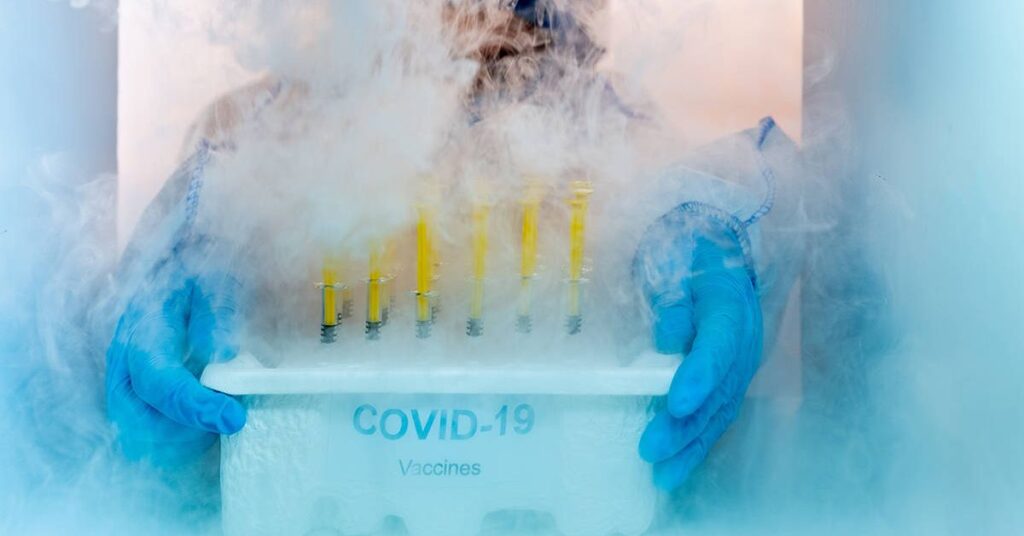Frio gif ultra baja temperatura gif combines the worlds of science and internet culture. It refers to animated images depicting ultra-low temperature freezers. These GIFs visually represent the extreme cold used in scientific research.
Ultra-low temperature freezers are crucial tools in laboratories and medical facilities. They maintain temperatures as low as -86°C (-122.8°F). These freezers preserve sensitive biological samples and materials for long periods.
The term “frio” means “cold” in Spanish, emphasizing the freezing nature of these devices. GIFs of these freezers often show frosty interiors or digital displays. They capture the essence of cutting-edge refrigeration technology in a shareable, engaging format.
What Are Ultra-Low Temperature Freezers?
Ultra-low temperature (ULT) freezers are specialized cooling units. They maintain extremely cold temperatures. These freezers are crucial for scientific research and medical applications. ULT freezers typically operate at temperatures between –40°C and -86°C.
These freezers are not your everyday kitchen appliances. They are designed for professional use. Labs, hospitals, and research facilities rely on them. ULT freezers preserve sensitive biological samples.
The term “frio gif ultra baja temperatura gif” combines Spanish and English. It refers to GIFs depicting these super-cold freezers. These GIFs often show frost, ice, or temperature displays. They visually represent the extreme cold these freezers produce.
Key Features
ULT freezers come with several essential features:
- Precise temperature control
- Robust insulation
- Backup cooling systems
- Alarm systems for temperature fluctuations
- Data logging capabilities
- Energy-efficient designs
- Multiple storage compartments
These features ensure sample integrity. They also provide user safety and operational efficiency.
How Do Ultra-Low Temperature Freezers Work?
ULT freezers employ advanced cooling technologies. They use a cascade refrigeration system. This system allows for reaching and maintaining ultra-low temperatures.
The process involves multiple stages of cooling. Each stage brings the temperature lower. It’s like a relay race where each runner takes the baton further.
Refrigeration Cycles
The refrigeration cycle in ULT freezers is complex:
- Primary cycle: Cools to about -40°C
- Secondary cycle: Further cools to -86°C or lower
- Heat exchangers transfer heat between cycles
- Compressors pressurize refrigerants
- Expansion valves allow refrigerants to expand and cool
This multi-stage process ensures efficient cooling. It maintains stable ultra-low temperatures.
Types of Ultra-Low Temperature Freezers
There are several types of ULT freezers available:
- Upright freezers: These resemble tall refrigerators. They offer easy access to samples. Upright models are popular in labs with limited floor space.
- Chest freezers: These have a horizontal design. They open from the top. Chest freezers often provide better temperature stability. However, they require more floor space.
- Under-counter freezers: These are compact units. They fit beneath lab benches. They’re ideal for smaller labs or as supplementary storage.
- Portable ULT freezers: These are designed for field work. They can be transported to remote locations. Portable units are crucial for on-site sample preservation.
Each type has its advantages. The choice depends on specific needs and constraints.
Applications of Ultra-Low Temperature Freezers
ULT freezers have diverse applications across scientific fields:
- Medical research: Preserving tissue samples, blood components, and genetic material
- Pharmaceutical industry: Storing vaccines and drug compounds
- Biotechnology: Maintaining cell lines and enzymes
- Cryobiology: Studying organisms at very low temperatures
- Environmental science: Preserving ice core samples
- Food science: Researching food preservation techniques
These freezers are indispensable in modern scientific endeavors. They enable long-term storage of critical samples.
Understanding GIFs and Their Popularity

GIFs have become a ubiquitous part of digital communication. These animated image files capture brief moments of motion or emotion. They’ve evolved from simple graphics to a powerful form of visual expression.
The popularity of GIFs stems from their versatility and ease of use. They can convey complex ideas or reactions in a matter of seconds. GIFs bridge language barriers, making them a universal form of online communication.
What is a GIF?
GIF stands for Graphics Interchange Format. It’s a type of image file. GIFs can be static or animated. Animated GIFs are a series of images played in sequence. They create a short, looping video effect.
GIFs were invented in 1987. They’ve since become a staple of internet culture. GIFs are compact and easy to share. They work across various platforms and devices.
Why Are GIFs So Popular?
GIFs have gained immense popularity for several reasons:
- They convey emotions quickly
- GIFs add humor to conversations
- They’re easy to share on social media
- GIFs can express complex ideas simply
- They’re more engaging than static images
- GIFs often reference popular culture
People use GIFs to react, express themselves, and connect with others online. They’ve become a visual language of their own.
Read As:Landhomeins: A Comprehensive Overview
The Concept of ‘Frio’ and Its Significance
The concept of ‘frio’ holds profound significance in the realm of ultra-low temperature freezers. Meaning ‘cold‘ in Spanish, ‘frio’ encapsulates the essence of these specialized devices designed to maintain extremely low temperatures.
In scientific contexts, ‘frio‘ represents more than just coldness; it symbolizes precision, preservation, and technological advancement. The term bridges cultural understanding with technical expertise, making complex scientific concepts more relatable to a wider audience.
What Does ‘Frio’ Mean?
“Frio” is Spanish for “cold.” In the context of ULT freezers, it emphasizes the extreme cold. The word evokes a sense of chilling temperatures. It’s used to describe the freezing environment inside these devices.
The term “frio” in “frio gif ultra baja temperatura gif” sets the tone. It immediately conveys the idea of coldness. This is crucial for understanding the purpose of ULT freezers.
Cultural Interpretations of ‘Frio’
“Frio” carries different connotations across cultures:
- In Spanish-speaking countries, it’s associated with winter and discomfort
- Some cultures view cold as purifying or preserving
- In scientific contexts, “frio” implies precision and control
- It can symbolize challenges or hardships in metaphorical use
The use of “frio” in scientific terminology bridges cultural and technical worlds. It makes complex concepts more relatable.
The Allure of ‘Frio Gif Ultra Baja Temperatura Gif’
The allure of ‘Frio Gif Ultra Baja Temperatura Gif’ lies in its captivating visual representation of extreme cold. These GIFs bring to life the fascinating world of ultra-low temperature freezers, showcasing the harsh beauty of frost and ice formations.
Combining scientific intrigue with aesthetic appeal, ‘Frio Gif Ultra Baja Temperatura Gif‘ captures the imagination of both researchers and casual observers. They offer a glimpse into the cutting-edge technology used in preserving vital samples, making complex scientific concepts more accessible and engaging to a wider audience.
What Makes It ‘Ultra Baja Temperatura’?
“Ultra baja temperatura” means “ultra-low temperature” in Spanish. This phrase describes the extreme cold in ULT freezers. It’s not just cold; it’s ultra-cold.
These temperatures are far below what we experience in daily life. They’re colder than the coldest places on Earth. This extreme cold is fascinating to many people.
Visual Appeal of Frio GIFs
Frio GIFs about ULT freezers are visually striking:
- They often show frost formations
- Digital displays showing ultra-low temperatures
- Steam rising when freezers are opened
- Scientists in protective gear handling samples
- Time-lapse videos of freezing processes
These GIFs capture the essence of extreme cold. They make invisible temperatures visible. This visual representation helps people understand the concept better.
How to Use Frio GIFs Effectively
Frio GIFs, depicting ultra-low temperature freezers, can be powerful visual tools when used effectively. They can convey complex scientific concepts in a simple, engaging manner across various digital platforms.
Properly utilizing frio GIFs can enhance communication in both professional and casual settings. From illustrating research techniques to expressing extreme cold, these animated images offer versatility in online interactions.
In Social Media
Using frio GIFs on social media can be impactful:
- Share them to illustrate scientific concepts
- Use them to express feeling extremely cold
- Include them in posts about breakthrough research
- React to news about medical discoveries
- Create engagement by asking followers to caption frio GIFs
Social media platforms like Twitter and Facebook support GIFs natively. This makes sharing and viewing frio GIFs easy and accessible.
In Messaging Apps
Frio GIFs can enhance messaging conversations:
- Send them to complain about cold weather
- Use them to discuss scientific topics
- Share when talking about preserving food
- React to friends’ messages about feeling chilly
- Add humor to conversations about lab work or research
Many messaging apps have built-in GIF keyboards. This makes finding and sending frio GIFs quick and convenient.
Where to Find the Best Frio GIFs

Searching for high-quality Frio GIFs (cold or freezing-themed animated images) can be an enjoyable quest. Popular platforms like GIPHY, Tenor, and Reddit’s r/GIFs often feature a wide selection of cold-themed animations.
Social media sites such as Twitter and Instagram can also be great sources for unique and trending Frio GIFs. Additionally, creative commons websites like Wikimedia Commons sometimes offer free-to-use animated images related to cold temperatures or freezing phenomena.
Popular GIF Platforms
Several platforms offer a wide selection of frio GIFs:
- Giphy: One of the largest GIF databases
- Tenor: Integrated with many messaging apps
- Reddit: Subreddits dedicated to science GIFs
- Imgur: Popular image-sharing site with many GIFs
- Gfycat: Known for high-quality GIFs
These platforms allow users to search, view, and share GIFs easily. Many offer categories or tags related to science and cold temperatures.
Creating Your Own GIFs
You can also create your own frio GIFs:
- Use smartphone apps like GIPHY Cam
- Convert video clips to GIFs using online tools
- Use professional software like Adobe Photoshop
- Create animations from scratch using specialized software
- Record actual footage of ULT freezers and convert to GIF format
Creating custom GIFs allows for unique, personalized content. It’s a way to contribute to the growing collection of frio GIFs online.
Key Components of Ultra-Low Temperature Freezers
ULT freezers consist of several crucial components:
- Compressors: These are the heart of the cooling system. They compress refrigerant gases. ULT freezers often use multiple compressors for efficiency.
- Insulation: High-quality insulation is vital. It prevents heat from entering the freezer. Vacuum insulated panels are common in modern ULT freezers.
- Temperature sensors: These monitor internal temperatures constantly. They ensure the freezer maintains the set temperature.
- Control panel: This allows users to set and monitor temperatures. It often includes alarm settings and data logging features.
- Door seals: Special gaskets prevent warm air from entering. They must withstand extreme temperature differences.
- Shelving systems: These organize samples efficiently. They’re designed for easy access while minimizing temperature fluctuations.
- Backup systems: Many ULT freezers have CO2 or LN2 backup systems. These maintain temperatures during power outages.
Understanding these components is crucial for proper maintenance and troubleshooting.
Benefits of Using Ultra-Low Temperature Freezers
ULT freezers offer numerous advantages:
- Long-term sample preservation: They maintain sample integrity for years.
- Versatility: They can store various types of biological materials.
- Reduced sample degradation: Ultra-low temperatures slow down chemical reactions.
- Compliance with regulations: Many research protocols require ULT storage.
- Increased research capabilities: They enable studies that require long-term sample storage.
- Protection of valuable materials: Irreplaceable samples are safeguarded.
- Consistency in research: Samples remain stable over time, ensuring reliable results.
These benefits make ULT freezers indispensable in modern scientific research.
Challenges in Using Ultra-Low Temperature Freezers
Despite their benefits, ULT freezers present some challenges:
- High energy consumption: Maintaining ultra-low temperatures requires significant power.
- Heat output: The cooling process generates heat, affecting room temperature.
- Maintenance costs: Regular servicing and potential repairs can be expensive.
- Space requirements: ULT freezers, especially larger models, need considerable floor space.
- Noise levels: The compressors can be noisy, potentially disrupting lab environments.
- Frost buildup: Regular defrosting may be necessary to maintain efficiency.
- Sample organization: Managing large numbers of samples at ultra-low temperatures can be challenging.
Addressing these challenges is crucial for effective use of ULT freezers.
How to Choose the Right Ultra-Low Temperature Freezer
Selecting the appropriate ULT freezer involves several considerations:
- Size and capacity: Determine your storage needs now and in the future.
- Temperature range: Ensure it meets your specific requirements.
- Energy efficiency: Look for models with good energy ratings.
- Reliability: Research brands known for dependable performance.
- Safety features: Check for alarms, backup systems, and monitoring capabilities.
- Cost: Consider both initial purchase price and long-term operational costs.
- Service and support: Evaluate the manufacturer’s customer service reputation.
- Noise levels: Consider the impact on your work environment.
- Footprint: Ensure you have adequate space for the freezer.
Take time to assess your needs carefully. Consult with colleagues who use ULT freezers. Demo different models if possible before making a decision.
Maintenance Tips for Ultra-Low Temperature Freezers
Proper maintenance ensures optimal performance and longevity:
- Regular cleaning: Keep the interior and exterior clean. Use appropriate cleaning agents.
- Check door seals: Inspect and clean door gaskets regularly. Replace if damaged.
- Defrost as needed: Follow manufacturer guidelines for defrosting schedules.
- Monitor temperatures: Regularly check and log internal temperatures.
- Organize samples: Maintain a clear inventory system. Minimize door opening times.
- Check alarm systems: Test alarms periodically to ensure they’re functioning.
- Filter maintenance: Clean or replace air filters as recommended.
- Professional servicing: Schedule annual maintenance with qualified technicians.
- Backup system checks: Regularly test CO2 or LN2 backup systems if installed.
- Keep area clear: Ensure proper ventilation around the freezer.
Following these tips can prevent issues and extend the life of your ULT freezer.
Innovations in Ultra-Low Temperature Freezers
Recent advancements have improved ULT freezer technology:
- Energy-efficient designs: Newer models use less power while maintaining performance.
- Smart monitoring: IoT-enabled freezers allow remote temperature monitoring and alerts.
- Touchscreen interfaces: User-friendly controls enhance ease of use.
- Improved insulation: Advanced materials provide better temperature stability.
- Eco-friendly refrigerants: Some models use natural refrigerants with lower environmental impact.
- Faster cool-down times: Quicker recovery after door openings.
- Quieter operation: Improved compressor designs reduce noise levels.
- Enhanced backup systems: More reliable power failure protection.
These innovations make ULT freezers more efficient, reliable, and user-friendly.
Cost Considerations for Ultra-Low Temperature Freezers
Investing in a ULT freezer involves several cost factors:
- Initial purchase price: ULT freezers are significant investments. Prices vary widely based on size and features.
- Energy costs: Operating costs can be substantial due to high power consumption.
- Maintenance expenses: Regular servicing and potential repairs add to long-term costs.
- Installation costs: Professional installation may be required, especially for larger units.
- Backup systems: CO2 or LN2 backup systems are additional expenses.
- Training: Staff may need training to operate and maintain the freezer properly.
- Accessories: Sample storage boxes, racks, and monitoring systems are extra costs.
- Replacement parts: Components like filters and gaskets need periodic replacement.
Consider total cost of ownership when budgeting for a ULT freezer. Look beyond the initial price tag.
Safety Precautions When Using Ultra-Low Temperature Freezers
Safety is paramount when working with ULT freezers:
- Wear appropriate PPE: Use insulated gloves and face shields when accessing the freezer.
- Avoid skin contact: Ultra-low temperatures can cause instant frostbite.
- Proper training: Ensure all users are trained in safe operation procedures.
- Ventilation: Install freezers in well-ventilated areas to prevent gas buildup.
- Emergency procedures: Have clear protocols for power failures or malfunctions.
- Sample safety: Use appropriate containers to prevent sample breakage.
- Signage: Clearly label the freezer with safety warnings and operating instructions.
- Access control: Limit access to authorized personnel only.
- Regular inspections: Check for any signs of wear or damage regularly.
Following these precautions protects both personnel and valuable samples.
Environmental Impact of Ultra-Low Temperature Freezers
ULT freezers have significant environmental considerations:
- Energy consumption: They use substantial amounts of electricity, contributing to carbon emissions.
- Refrigerants: Some older models use refrigerants with high global warming potential.
- Heat output: The heat generated can increase cooling needs in labs.
- Disposal challenges: Proper disposal of old units is crucial to prevent environmental harm.
- Manufacturing impact: Production of ULT freezers involves resource-intensive processes.
Efforts to mitigate these impacts include:
- Developing more energy-efficient models
- Using eco-friendly refrigerants
- Implementing power management strategies in labs
- Recycling programs for old freezers
- Choosing Energy Star certified models when available
Considering environmental factors is increasingly important in ULT freezer selection and use.
Common Myths About Ultra-Low Temperature Freezers

Several misconceptions surround ULT freezers:
Myth 1: Colder is always better.
Reality: The optimal temperature depends on the specific samples being stored.
Myth 2: ULT freezers never need defrosting.
Reality: Regular defrosting is often necessary for optimal performance.
Myth 3: All ULT freezers are the same.
Reality: There are significant differences in quality, efficiency, and features between models.
Myth 4: ULT freezers are maintenance-free.
Reality: Regular maintenance is crucial for longevity and reliability.
Myth 5: Samples are safe as long as the freezer is running.
Reality: Proper sample preparation and storage practices are also essential.
Understanding these realities helps in better utilization of ULT freezers.
Frequently Asked Questions
H3: What is the lowest temperature a ULT freezer can reach?
Most ULT freezers can reach temperatures as low as -86°C. Some specialized models go even lower.
H3: How long do samples last in a ULT freezer?
Properly stored samples can last for decades. The exact duration depends on the sample type and storage conditions.
H3: Are ULT freezers safe to use in small labs?
Yes, with proper ventilation and safety precautions. Smaller models are available for space-constrained labs.
H3: How often should ULT freezers be serviced?
Annual professional serv









